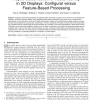Free Online Productivity Tools
i2Speak
i2Symbol
i2OCR
iTex2Img
iWeb2Print
iWeb2Shot
i2Type
iPdf2Split
iPdf2Merge
i2Bopomofo
i2Arabic
i2Style
i2Image
i2PDF
iLatex2Rtf
Sci2ools
TOH
2010
2010
Haptic Classification of Facial Identity in 2D Displays: Configural versus Feature-Based Processing
—Participants learned through feedback to haptically classify the identity of upright versus inverted versus scrambled faces depicted in simple 2D raised-line displays. We investigated whether identity classification would make use of a configural face representation, as is evidenced for vision and 3D haptic facial displays. Upright and scrambled faces produced equivalent accuracy, and both were identified more accurately than inverted faces. The mean magnitude of the haptic inversion effect for 2D facial identity was a sizable 26 percent, indicating that the upright orientation was “privileged” in the haptic representations of facial identity in these 2D displays, as with other facial modalities. However, given the effect of scrambling, we conclude that configural processing was not employed; rather, only local information about the features was used, the features being treated as oriented objects within a bodycentered frame of reference. The results indicate a fundamental diffe...
| Added | 31 Jan 2011 |
| Updated | 31 Jan 2011 |
| Type | Journal |
| Year | 2010 |
| Where | TOH |
| Authors | Tara A. McGregor, Roberta L. Klatzky, Cheryl L. Hamilton, Susan J. Lederman |
Comments (0)

